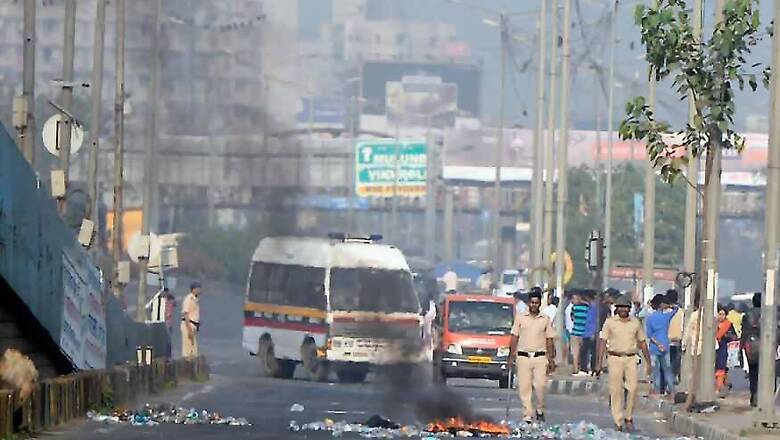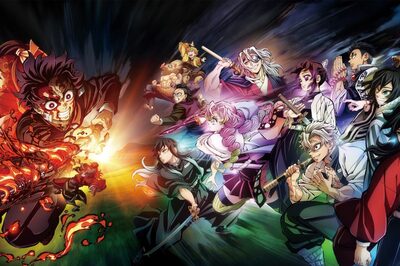
views
On Tuesday morning, Dalits took to the streets of Mumbai in protest. Hundreds of Dalits were protesting against the violence during the 200th-anniversary celebrations of the Bhima-Koregaon battle in Pune district. One person had died in the violence.
Prohibitory orders to stop the gathering of more than four people were imposed in parts of the country's financial capital, several schools and colleges were shut, and traffic was hit on Eastern Express Highway near Mumbai. Meanwhile, Chief Minister Devendra Fadnavis has appealed for peace, saying Maharashtra is a “progressive state which does not believe in casteist violence”.
On Monday, groups of Dalits, who were on way to an event near Pune city, to mark 200 years of the Bhima Koregaon battle were attacked and their vehicles were damaged. The celebration of the Bhima Koregaon battle pointed to a sort of re-emergence of the Dalit militancy. It was their way of telling the world: We won’t silently suffer through the existing caste hierarchies.
The Dalits, together, were out to celebrate the militancy that is part of their history, and not the history that has shoved down their throat.
And that’s what they were doing. They were celebrating Bhima Koregaon that revolves around the defeat of Peshwas by the untouchable soldiers of the colonial army at that time. In the Dalit history, it’s a heroic chapter.
When several lakhs of Dalits congregated around the Victory Pillar (Vijay Stambh) erected by the British in Sanaswadi village, stone pelting began; allegedly by some right-wing groups carrying saffron flags. In the clashes that ensued between the two groups, more than 30 vehicles, including buses, police vans and private vehicles, were torched or damaged. And in the end, the Dalits couldn’t have a peaceful gathering.
History shows that Dalit atrocities in the land of Ambedkar isn’t new.
On September 29, 2006, Bhotmange went to work on his farm near the village, and when he came back, he found his wife Surekha, 45, daughter Priyanka, 17, sons Sudhir and Roshan, 21 and 19, murdered by a mob. A mob of 40 people belonging to the Maratha Kunbi caste in Kherlanji, a small village in Bhandara district of Maharashtra, was responsible for it.
The women of the family were stripped, paraded, beat, raped and killed.
There were allegations that the local police shielded the alleged perpetrators in the ongoing investigation. A government report on the killings, prepared by the social justice department and YASHADA—the state academy of developmental administration, has implicated top police officers, doctors and even a BJP member of the Legislative Assembly, Madhukar Kukade in an alleged coverup and hindering the investigations.
Ten years after the Khairlanji massacre, 61-year-old Bhaiyyalal Bhotmange, who lost his family, is still waiting for justice.
Communal clashes in Maharashtra are in fact not rare at all.
In the last three years, there have been 270 reported cases of communal clashes in the state. In this, at least 32 people have been killed and over 500 injured.
In 2016, lakhs of people from Maharashtra's most powerful caste group, the Marathas, held a muk or silent rally in Pune to protest the rape and killing of a 14-year-old girl from the community by three Dalit boys in the village of Kopardi in Ahmednagar district. In this protest, the community demanded reservation in education and government services.
Meanwhile, they asked for the abolition of the Scheduled Caste/Scheduled Tribe Prevention of Atrocities Act (POA) 1989 because they say, the law which is meant to prevent and punish violence against Dalits and Adivasis, is being misused by these groups to target the Marathas. However, incidents over the years have shown that Maharashtra's weakest castes have little access to justice and continue to be victims of discrimination.
That same year, in September, four days after a five-year-old girl from the Banjara community was raped allegedly by a 40-year-old man belonging to the Maratha community in Nashik, there was a rise in tension between the Maratha and the OBC communities with both groups set to organise protests and marches.
The thunder of the massive ‘Muk Morcha’ staged by the Maratha outfits was undercut by a formidable march held simultaneously by members of the Other Backward Classes (OBC) community in Nashik. The OBC rally batted for the maintenance of the status quo in quota and demanded that the Scheduled Castes and Scheduled Tribes (Prevention of Atrocities) Act should not be tinkered with.
The huge rallies divided Maharashtra once again.
In December, when the nation was paying homage to Dr BR Ambedkar on his death anniversary, Dalit houses in Chinchner village near Satara were attacked by a mob. According to reports, Siddhaarth Danane and Aruna Mohite were in love. However, their parents disapproved of their relationship because they belonged to different castes. Mohite was married off to someone else, but they continued to be in touch. As the report suggests, Danane allegedly killed Mohite and buried her body one night after they had an argument. Mohite’s family attacked houses and vehicles belonging to Danane’s family. It turned into caste clashes, yet again.
Three days later, a Shiv Sena leader reached Satara and told the residents that this was a retaliation for killing of a Maratha girl and requested the victims of the mob attack to not label this as caste attack. The residents, in turn, told him that the mob, while burning their houses, was shouting caste slurs against Dalits and raising Maratha slogans. The state’s Chief Minister Devendra Fadanavis kept mum on Satara, despite constantly assuring Dalits that Atrocity Act would not be diluted.
The Bhima-Koregaon violence has once again brought to the fore the complex caste cauldron in the Maharashtra politics. Following the incident, when Fadnavis said, “Maharashtra was a progressive State which did not believe in casteist violence”, it wasn’t quite true. At least, history says otherwise.



















Comments
0 comment